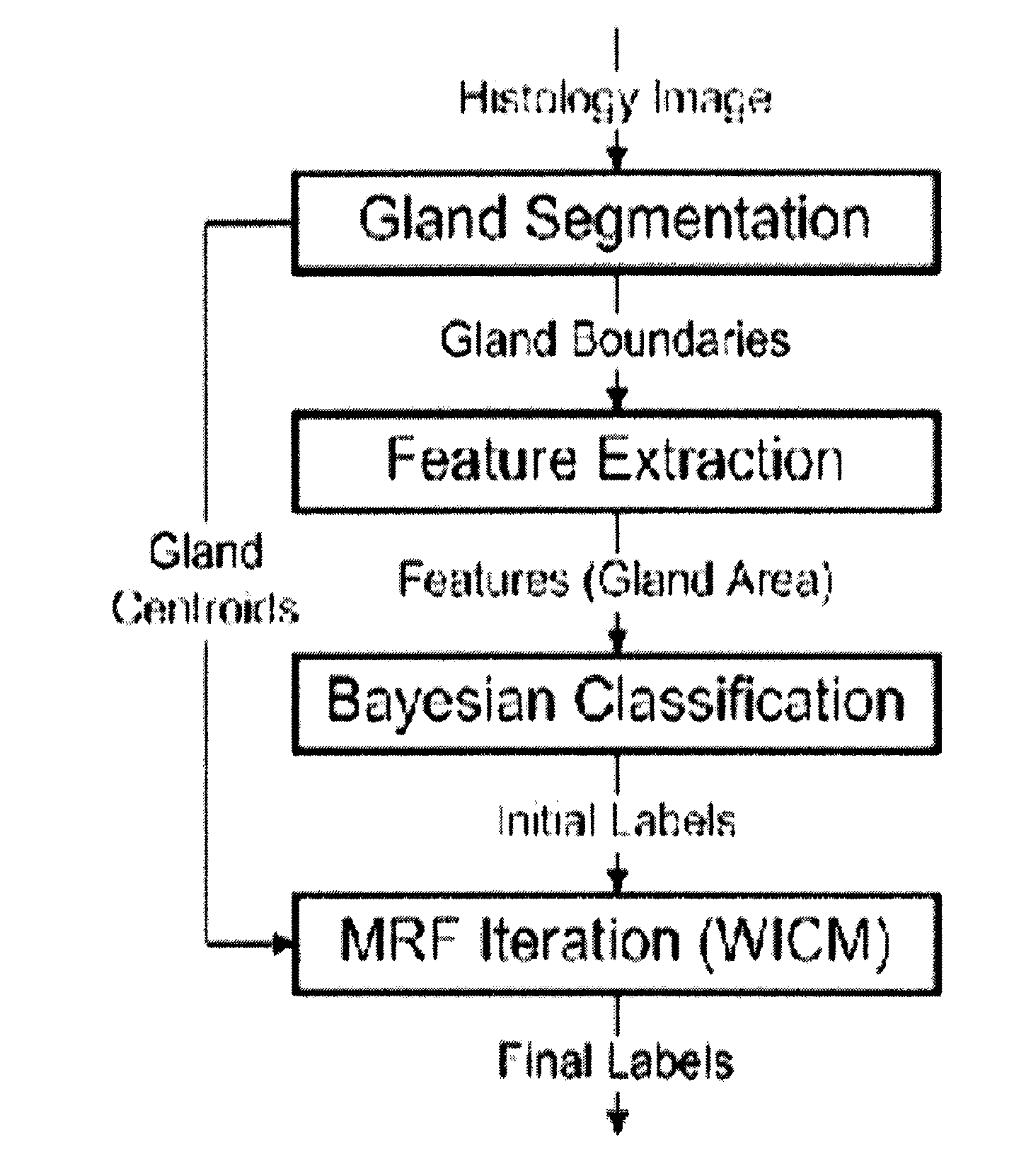System and method for accurate and rapid identification of diseased regions on biological images with applications to disease diagnosis and prognosis
a biological image and rapid detection technology, applied in image enhancement, image analysis, instruments, etc., can solve the problems of not anticipating whether or not the corrected lcdpfs is correct, the algorithm requires manual segmentation and classification of the gland, and the difficulty of modeling contextual information, etc., to achieve rapid processing of medical images, high throughput, and efficient
- Summary
- Abstract
- Description
- Claims
- Application Information
AI Technical Summary
Benefits of technology
Problems solved by technology
Method used
Image
Examples
embodiment i
of PPMMs to CaP Detection on Prostate Histological Sections
[0143]In the present embodiment, we demonstrate our novel classification system for detecting cancerous glands on digitized whole-mount histological sections of the prostate. In the present embodiment of the present invention, we utilize the fact that cancerous glands tend to be proximate to other cancerous glands. This information is incorporated via a Markov random held (MRF), which we formulate using both the Potts model and the PPMM of the present invention. To demonstrate the advantages of PPMMs of the present invention over typical Markov models (specifically the Potts model), we evaluate both in the context of an algorithm to detect prostate cancer (CaP) on digitized whole-mount histological sections (WMHSs) of radical prostatectomy specimens.
[0144]We first provide a basic outline of the algorithm and then discuss each component in detail.
Algorithm Overview
[0145]FIG. 3(a) illustrates a prostate histological (tissue) s...
embodiment ii
in Multi-Protocol MRI
[0172]An embodiment of the present invention provides a classification system for detecting CaP in ex vivo MRI. This system uses T2-weighted (T2-w) 3 Tesla MRI from 15 2D slices. FIG. 7(a) illustrates a T2-w MR image; the green overlay indicates the cancerous extent as specified by a radiologist. Let the set S={1, 2, . . . , N} reference the N pixels in the T2-w MR image that reside within the prostate. The random vector Ys ε represents the 21 features associated with pixel s. Each multi-dimensional distribution f(ys|xs) (one for each class) was modeled using 21 one-dimensional histograms. The neighborhood ηs of a pixel s is the typical 8-connected region. All results were produced using leave-one-out cross-validation.
Results
[0173]The intensities in FIG. 7(b) indicate the probability of malignancy at each pixel based solely assuming uniform priors (i.e. MLE). Those pixels labeled whose probability exceeds 1 / 2 are indicated by the red overlay in FIG. 7(c). FIGS. ...
embodiment iii
hocytic Infiltration in Breast Histology
[0174]Breast cancer (BC) is the second leading cause of cancer-related deaths in women, with more than 182,000 new cases of invasive BC predicted in the United States for 2008 alone. Researchers have shown that the presence of lymphocytic infiltration (LI) in histopathology is a viable prognostic indicator for various cancers, including breast cancers that exhibit amplification of the HER2 gene (HER2+ BC).
[0175]An embodiment of the present invention provides a computer-aided diagnosis (CADx) scheme (FIG. 9) to automatically detect and grade the extent of LI in digitized HER2+ BC histopathology images.
Automated Lymphocyte Detection Scheme
[0176]We first attempt to identify candidate image locations that could represent centers of lymphocytic nuclei. A region-growing algorithm exploits the fact that lymphocyte nuclei in the luminance channel are identified as continuous, circular regions of low intensity circumscribed by sharp, well-defined bound...
PUM
 Login to View More
Login to View More Abstract
Description
Claims
Application Information
 Login to View More
Login to View More - R&D
- Intellectual Property
- Life Sciences
- Materials
- Tech Scout
- Unparalleled Data Quality
- Higher Quality Content
- 60% Fewer Hallucinations
Browse by: Latest US Patents, China's latest patents, Technical Efficacy Thesaurus, Application Domain, Technology Topic, Popular Technical Reports.
© 2025 PatSnap. All rights reserved.Legal|Privacy policy|Modern Slavery Act Transparency Statement|Sitemap|About US| Contact US: help@patsnap.com



